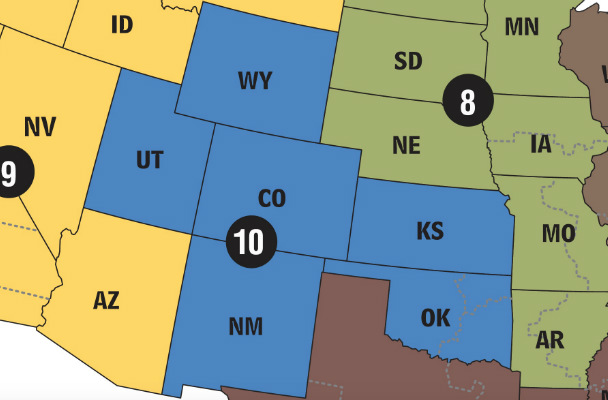Tenth Circuit Holds 2013 Changes to Black Lung Regulations Apply to Pending Cases (Antelope Coal Co. v. Goodin)

On March 3, 2014, in Antelope Coal Co./Rio Tinto Energy America v. Goodin, 743 F.3d 1331 the U.S. Court of Appeals for the Tenth Circuit affirmed a surface miner’s award of black lung benefits via a published opinion (decision here). The court held that the 2013 Regulations Implementing the Byrd Amendments to the Black Lung Benefits Act, apply to pending cases, making it easier for surface miners to qualify for the 15-year presumption.
(Disclosure: I provided my thoughts to the miner’s attorney when the court sought supplemental briefing on whether the 2013 regulations—which were released the day of oral argument—should apply. However, I authored no part of the brief.)
Rolland Goodin worked on surface mines in Wyoming for 25 years. Mr. Goodin testified that even though he worked in the air-filtered cabs of the equipment he operated, that “there was no way to keep the dust out,” and when he worked outside oiling the equipment, “it would get pretty dusty.” He retired because of respiratory health issues and filed for federal black lung benefits which the Department of Labor awarded.
His last employer, Antelope Coal Company, appealed his award of benefits arguing: (1) that Mr. Goodin’s surface mine working conditions were not substantially similar to those in an underground mine, (2) that the Administrative Law Judge (ALJ) wrongly limited the company’s ability to rebut the 15-year presumption, (3) that the ALJ incorrectly weighed the medical evidence, (4) that the Department of Labor’s pulmonary evaluation was incomplete because the x-ray was low quality, and (5) the ALJ failed to consider all of the medical evidence.
The court used the harmless error standard to avoid a holding regarding issues #2 and #4, but rejected the company’s other arguments.
Regarding the dust conditions on the surface mine, the court held that the lower “regularly exposed” standard (which was codified by the 2013 regulations) applied to Mr. Goodin’s case even though he filed his claim for benefits in 2007 and the regulations became effective the day of oral argument before the Tenth Circuit. Applying the retroactivity standard from National Mining Association v. Department of Labor, 292 F.3d 849, 859 (D.C. Cir. 2002), the court held that the regulations were substantially consistent with prior law and practice and thus it did not violate due process to apply the lower “regularly exposed” standard rather than the vaguer “substantially similar” standard. Because the court found that Mr. Goodin’s testimony showed he was “regularly exposed” to dust, the court held harmless the ALJ’s error of relying upon his personal understanding of the conditions of underground mines to determine whether Mr. Goodin’s conditions were “substantially similar” to underground coal mining conditions.
The court determined that the ALJ’s determination that the company did not rule out that Mr. Goodin’s disability was caused by pneumoconiosis from his work in the mines was supported by substantial evidence. The court did not need to reach the question of the possible methods of rebuttal because the ALJ did not limit the admissibility of evidence and the evidence did not support rebuttal under any method.
The court acknowledged that the x-ray that was performed as a part of Mr. Goodin’s Department of Labor examination was low quality, but found the error to be harmless because even if the x-ray had been completely favorable to the employer, Mr. Goodin’s award of benefits would be undisturbed.
Lastly, the court rejected the company’s arguments that the ALJ should have provided more explicit analysis of his consideration of the medical evidence. The court held that it was sufficient that the ALJ noted the existence of the evidence even if he did not discuss every aspect of it, especially because it was not clear that the evidence would have affected the outcome.
The court’s decision is favorable to miners, especially surface miners who can more easily prove that they are regularly exposed to dust rather than comparing their work to the conditions of an underground mine—a comparison that is particularly difficult for a miner such as Mr. Goodin whose entire career was above ground. Regarding the theoretical issues about the methods available to an employer who wishes to rebut the 15-year presumption, the court’s focus on whether the evidence supported rebuttal under any theory was prudential, but will likely lead to future litigation of this distinction without a difference. The court declined to encourage unnecessary remands based on immaterial issues such as the quality of an x-ray that the case does not turn upon or an ALJ’s decision not to thoroughly analyze why some evidence does not change his conclusion.
Congratulations to Jared Bramwell who represented Mr. Goodin and to Sean Bajkowsky who represented the Department of Labor.
4 Responses to “Tenth Circuit Holds 2013 Changes to Black Lung Regulations Apply to Pending Cases (Antelope Coal Co. v. Goodin)”
[…] exposed” standard for comparing surface-mine conditions to underground conditions. (See this previous post regarding the Tenth Circuit’s decision in Goodin for an example of a case in which the lower […]
[…] exposed” standard for comparing surface-mine conditions to underground conditions. (See this previous post regarding the Tenth Circuit’s decision in Goodin for an example of a case in which the lower […]
[…] this previous post regarding the Tenth Circuit’s decision in Goodin for an example of a case in which the lower […]
[…] The first issue is the major issue in this case. It is good to see that the Sixth Circuit held in accordance with the Tenth Circuit’s decision earlier this year in Antelope Coal Co./Rio Tinto Energy America v. Goodin, 743 F.3d 1331, 1342 (10th Cir. 2014), and thus all circuits to consider the issue agree that the new regs apply to pending cases. (See previous post about Antelope Coal here). […]
Comments are closed.